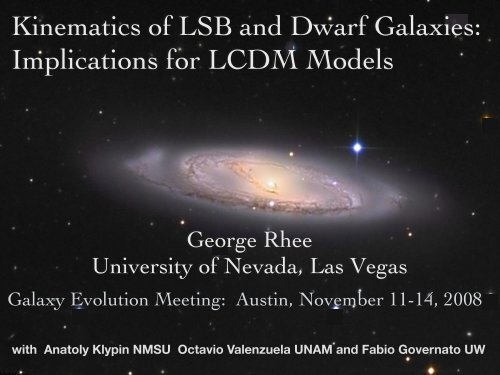Implications for LCDM Models - Astronomy Program - The University ...
Implications for LCDM Models - Astronomy Program - The University ...
Implications for LCDM Models - Astronomy Program - The University ...
You also want an ePaper? Increase the reach of your titles
YUMPU automatically turns print PDFs into web optimized ePapers that Google loves.
Kinematics of LSB and Dwarf Galaxies:<br />
<strong>Implications</strong> <strong>for</strong> <strong>LCDM</strong> <strong>Models</strong><br />
George Rhee<br />
<strong>University</strong> of Nevada, Las Vegas<br />
Galaxy Evolution Meeting: Austin, November 11-14, 2008<br />
with Anatoly Klypin NMSU Octavio Valenzuela UNAM and Fabio Governato UW
the rotation curve
example of spiral galaxy data<br />
NGC 891
Navarro et al 2008 astroph 0810.1522<br />
4.4 billion particles per halo<br />
log r [kpc/h]<br />
cusp is present between 0.2 and 1kpc with slope steeper than -1
Bars can modify the structure of the halo<br />
Katz and Weinberg ApJ (2002) 580, 627<br />
linear theory<br />
N-body
Dynamical friction of sub-clumps of baryons heats<br />
up halo overcomes adiabiatic contraction effect and<br />
creates a core<br />
Romano-Diaz et al ApJL (2008)<br />
El-Zant and Shlosman ApJ (2001)
Random bulk motions induced by stellar feedback can<br />
heat up the dark matter distribution removing the cusp<br />
<strong>The</strong> blue, green and red lines simulated halo after 40, 80 and 140 Myr,<br />
dotted line marks the radius A = 400 pc (the amplitude of the oscillations)<br />
Mashchenko, Couchman and James Wadsley Nature (2006)
<strong>The</strong> efficiency of the various mechanisms<br />
outlined above (to remove the cusp) versus<br />
adiabatic contraction (to enhance the cusp) is<br />
still an open question...
8+<br />
!"#"$%&"'#()%(#%"<br />
-.'/0%&"0%12%3"4$%56)#%(#%<br />
I12<br />
<strong>The</strong> real world<br />
IK(%12%
∞∑<br />
V t (r, θ) = V t (r) + V m,t (r) cos[mθ + θ m,t (r)]<br />
V r (r, θ) = V r (r) +<br />
1<br />
∞∑<br />
1<br />
V m,r (r) cos[mθ + θ m,t (r)]<br />
V obs = V sys + sin i(V t cos θ + V r sin θ)<br />
θ<br />
Modeling the line of sight velocity
Is H-alpha gas a good tracer of the potential?<br />
Kuzio de Naray et al. ApJ, 2008 Yes, no need <strong>for</strong> asymmetric drift<br />
correction
Is H-alpha gas a good tracer of the potential?<br />
Pizzella et al integral field spectroscopy of 3 LSB<br />
galaxies with VMOS VLT<br />
velocity residuals from rotation curve fit are substantial!
compare gas (red) vs stars (black) along LSB minor axis
can we quantify non-circular motions?<br />
eg: <strong>for</strong> bar symmetry use m=2 terms<br />
V model = V sys + sin i[V t cos θ − V 2,t cos(2θ b ) − V 2,r sin(2θ b ) sin(θ)]<br />
θ b = θ − φ b<br />
φ b is the bar position angle<br />
most spiral galaxies are barred
Apply to NGC 2976 Spekkens & Sellwod 2007
<strong>The</strong> HI Nearby Galaxy Survey<br />
19 nearby 3< D < 15Mpc disk galaxies at high spatial and<br />
velocity resolution
THINGS approach to non-circular motions<br />
V los (r) = V sys (r) +<br />
3∑<br />
m=1<br />
c m (r) cos mθ + s m (r) sin mθ<br />
ɛ pot sin(2ϕ 2 ) = (s 3 − s 1 ) 1 + 2q2 + 5q 4<br />
c1(1 − q 4 )<br />
q = cos(i)<br />
ϕ 2<br />
is the angle between the minor axis of the elongated ring and the observer<br />
n.b. epicycle theory applies to gas on closed orbits and small distortions
PV diagram major axis<br />
PV diagram minor axis<br />
Spitzer irac 3.6 micron<br />
HI map VLA
esiduals to the tilted ring fit<br />
white -30km/s to +30km/s black<br />
eg ngc 3198
intensity weighted mean velocity -24.3km/s<br />
maximum velocity -36.8 km/s<br />
0.04<br />
0.02<br />
0<br />
NGC 6822<br />
-50 0 50<br />
radial velocity km/s
NGC 6822 semi major axis 0.5kpc<br />
position angle
ngc 6822 residuals from circular rotation fit
where do we go from here?<br />
1. we need better theoretical predictions: DM simulations predict a<br />
cusp on the scale 0.1~1 kpc but what about the effects of baryons?<br />
2. when comparing models to data try to use models that more closely<br />
match real galaxies (eg Governato’s talk) rather than epicycle<br />
approximation which may not apply<br />
3. As well as using different data sets, examine the same data sets eg<br />
NGC 6822 (Rhee et al in prep) so we can reach agreement on the<br />
amplitude of non-circular motions and how best to measure them<br />
4. Given difficulties with gas, try to obtain rotation curves of galaxies<br />
using optical emission from the stars (difficult but worth the ef<strong>for</strong>t)













